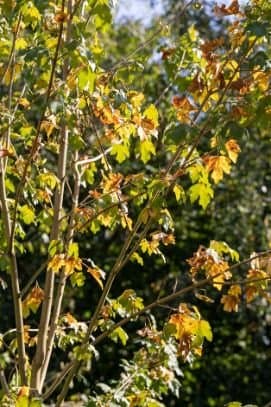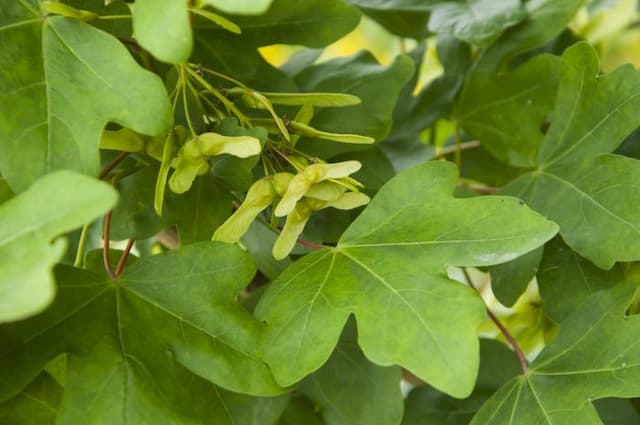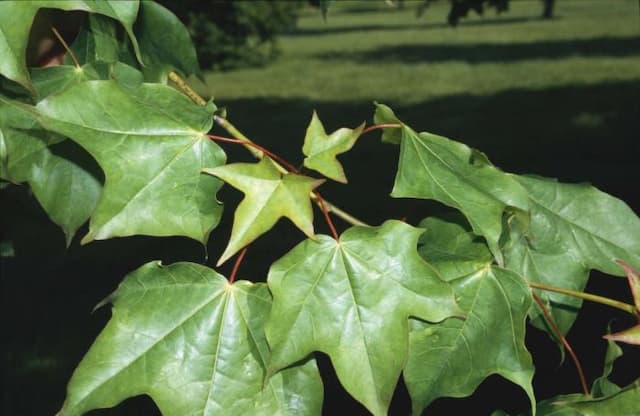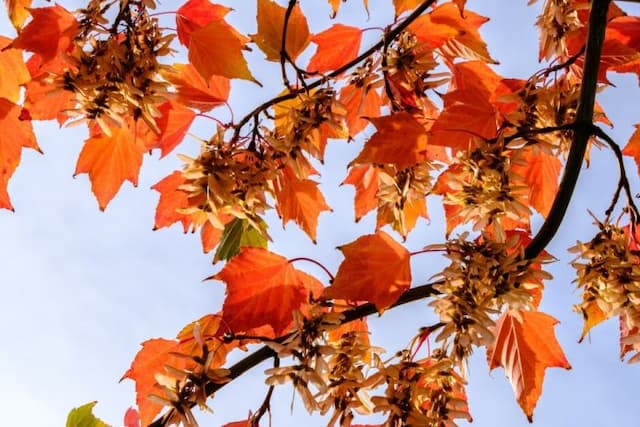Indian Horse Chestnut Aesculus indica

ABOUT
The Indian Horse Chestnut, is a deciduous tree renowned for its striking beauty and distinctive foliage. The leaves of this tree are quite large, and they are composed of five to seven leaflets that radiate from a central point, somewhat like the fingers on a hand. These leaflets are oblong with a pointed tip and a serrated edge, lending a coarse texture to the foliage. The leaves are a vibrant green color that can turn to golden yellow or brown before they fall off in the autumn season. During spring and early summer, the Indian Horse Chestnut produces impressive spires of flowers known as panicles. These flowers can be quite showy, predominantly white with flecks of yellow or pink at the base, and are arranged in tall, cone-shaped clusters that rise above the foliage. The flowers not only add visual interest but also attract various pollinators with their light, pleasant fragrance. After the flowering period, the tree produces its fruit. The fruit is a green, spiky capsule that encases one or more seeds. As time passes, the capsule hardens and eventually splits open to release the seeds, which are glossy and brown, resembling conkers, a common name given to horse chestnut seeds. The bark of the Indian Horse Chestnut tree is another notable feature, it is smooth and gray when young and becomes darker and rougher with age, often developing fissures and ridges. This bark texture provides an attractive contrast to the graceful canopy of the tree throughout the year. Despite its name and seed appearance, this tree is not related to true chestnut trees and its seeds are not edible. In landscaping, the Indian Horse Chestnut is valued for its ornamental characteristics; its flowers, leaves, and overall form make it a majestic addition to parks and large gardens, though it is important to note that due to its size and root system, it is more suited to spacious environments.
About this plant
 Names
NamesSynonyms
Indian Horse Chestnut, Himalayan Chestnut, Asian Chestnut
Common names
Aesculus assamica, Pavia indica
 Toxicity
ToxicityTo humans
The plant commonly known as Indian Horse Chestnut (Aesculus indica) contains toxic compounds, notably saponins and possibly alkaloids, which can be harmful if ingested. The seeds, leaves, and bark pose the greatest risk. If parts of the Indian Horse Chestnut are consumed, symptoms of poisoning may include nausea, vomiting, diarrhea, stomach pain, a dilated pupil, weakness, paralysis and, in severe cases, can lead to respiratory failure or death. It is crucial to seek immediate medical attention if ingestion is suspected.
To pets
Indian Horse Chestnut (Aesculus indica) is also toxic to pets due to the presence of compounds such as saponins. When ingested by animals, parts of the plant, particularly the seeds, can cause symptoms like vomiting, diarrhea, depression, and weakness. In severe cases, muscle tremors, coordination issues, and respiratory distress can occur. Consumption of this plant by pets should be considered an emergency, and immediate veterinary care is necessary.
 Characteristics
CharacteristicsLife cycle
Perennials
Foliage type
Deciduous
Color of leaves
Green
Flower color
White
Height
50 feet (15.24 meters)
Spread
30 feet (9.14 meters)
Plant type
Tree
Hardiness zones
7
Native area
Himalayas
Benefits
 General Benefits
General Benefits- Landscape Ornamentation: Aesculus indica, commonly known as the Indian horse chestnut, is valued for its aesthetic appeal, with a striking display of large, palmate leaves and tall spires of white or pink flowers that can enhance the visual appeal of gardens and parks.
- Shade Provision: The canopy of the Indian horse chestnut is dense and broad, making it an effective shade provider in hot climates, creating cool spots for relaxation and protection from the sun.
- Habitat for Wildlife: The flowers of Aesculus indica provide a source of nectar for bees and other pollinators, while the tree itself can offer shelter and nesting sites for various bird species.
- Erosion Control: With its extensive root system, the Indian horse chestnut can help stabilize soil and prevent erosion, particularly on slopes or in areas prone to heavy rains.
- Tannin Production: The bark of the Indian horse chestnut contains tannins, which can be extracted for use in the leather tanning industry or as a natural dye.
- Education and Research: As a species with distinct characteristics, Aesculus indica serves as a valuable subject for botanical studies and educational programs, helping students and researchers understand plant biology and ecology.
- Horticultural Use: Indian horse chestnut is often used in horticulture for grafting and as a rootstock for other Aesculus species, aiding in the propagation of ornamental trees.
 Medical Properties
Medical Properties- Anti-inflammatory: Aesculus indica has been traditionally used to reduce inflammation.
- Pain relief: The plant's extracts have been used to alleviate pain, particularly in cases of rheumatism and arthritis.
- Venotonic: It is believed to strengthen veins and improve circulation, which can be helpful in the treatment of venous insufficiency.
- Antioxidant: Containing compounds that can act as antioxidants, Aesculus indica offers potential protection against oxidative stress.
- Anti-edema: The plant might be used to reduce edema, or swelling, particularly in cases of chronic venous insufficiency.
 Air-purifying Qualities
Air-purifying QualitiesThis plant is not specifically known for air purifying qualities.
 Other Uses
Other Uses- In woodworking, the wood of the Indian Horse Chestnut (Aesculus indica) is sometimes carved into decorative items or furniture, as it is relatively easy to work with due to its softness.
- The seeds of the Indian Horse Chestnut can be used as a starch substitute after extensive processing to remove toxins, and in periods of famine have been used as a food source.
- The bark of the Indian Horse Chestnut can be utilized in tanning leather due to the presence of tannins.
- Indian Horse Chestnut's large, dark green leaves can be used as packing material for transporting fragile items in rural areas.
- Its aesthetically pleasing flowers are used for decorative purposes in festivals and rituals in its native region.
- Conkers, the seeds of the Indian Horse Chestnut, have been used in traditional children's games in many parts of the world.
- The wood of the Indian Horse Chestnut is burned as fuel in rural areas where other sources of energy may not be readily available.
- Fine-grained sawdust from the wood can be used as a component in the manufacture of particleboard or pressed wood products.
- Indian Horse Chestnut trees can be planted as a way to stabilize soil and prevent erosion on slopes or river banks.
- The tree is grown for ornamental purposes in temperate climates around the world due to its stately appearance and showy flowers.
Interesting Facts
 Feng Shui
Feng ShuiThe Indian Horse Chestnut is not used in Feng Shui practice.
 Zodiac Sign Compitability
Zodiac Sign CompitabilityThe Indian Horse Chestnut is not used in astrology practice.
 Plant Symbolism
Plant Symbolism- Strength: The Aesculus indica, commonly known as the Indian Horse Chestnut, symbolizes strength due to its solid and majestic tree form that can withstand harsh conditions.
- Endurance: With its ability to live for many years, the Indian Horse Chestnut is often associated with endurance and resilience, facing the elements with an unyielding presence.
- Fertility: The abundant and showy flowers of the Indian Horse Chestnut are symbols of fertility, signifying the potential for new growth and abundance.
- Protection: The firm and robust nature of the Indian Horse Chestnut's wood, along with its thick canopy, traditionally symbolizes protection, offering shelter and refuge.
- Healing: Various parts of the tree, like its bark and seeds, have been used in traditional medicine, making the Indian Horse Chestnut a symbol of healing and medicinal properties.
 Water
WaterThe Indian Horse Chestnut requires regular watering, especially during the growing season, but it is essential to avoid waterlogging the soil as this can lead to root rot. Typically, the plant should be watered once a week with approximately 1-2 gallons of water, ensuring the soil is moist but not saturated. During hot, dry periods, you may need to increase the frequency of watering to maintain consistent soil moisture. In the dormant season, reduce watering to every other week to match the plant's reduced water needs.
 Light
LightThe Indian Horse Chestnut thrives best in full sunlight to partial shade. A spot that receives at least four to six hours of direct sunlight daily is ideal for this plant, ensuring a balance of light and shade to promote healthy growth and flowering.
 Temperature
TemperatureThe Indian Horse Chestnut prefers moderate temperature ranges and can withstand a minimum temperature of about 20 degrees Fahrenheit. Ideally, the plant should be grown in conditions where temperatures range from 50 to 75 degrees Fahrenheit for optimal growth. It can survive short spikes above this range, but sustained extreme temperatures can be detrimental to the plant's health.
 Pruning
PruningPruning the Indian Horse Chestnut is important to maintain its shape, remove dead or diseased branches, and encourage healthy growth. The best time to prune is in late winter or early spring before new growth begins. Light annual pruning is often enough, removing any branches that are crossing or growing inward, to improve air circulation and light penetration throughout the canopy.
 Cleaning
CleaningAs needed
 Soil
SoilThe Indian Horse Chestnut prefers a well-drained loamy or sandy soil with a pH range between 6.0 to 7.5. A mix of two parts loam, one part peat, and one part coarse sand or perlite is ideal for proper drainage and root development.
 Repotting
RepottingThe Indian Horse Chestnut should be repotted every 2-3 years to ensure healthy growth. Repotting is best done in the late winter or early spring before new growth starts.
 Humidity & Misting
Humidity & MistingThe Indian Horse Chestnut thrives in moderate humidity levels, around 40-60%. Extreme humidity fluctuations should be avoided to maintain the plant's health.
 Suitable locations
Suitable locationsIndoor
Plant Indian Horse Chestnut in large pots with drainage holes and ample space.
Outdoor
Choose a sunny spot, mulch well, and protect from strong winds for Indian Horse Chestnut.
Hardiness zone
6-8 USDA
 Life cycle
Life cycleIndian Horse Chestnut (Aesculus indica) begins its life cycle as a seed, which is typically a large, round nut. After a period of dormancy and once conditions are favorable, the seed germinates, sending out a root to anchor into the soil and a shoot that grows upwards. As a seedling, it develops true leaves and begins photosynthesis, eventually growing into a sapling. The sapling stage is characterized by rapid growth as the plant establishes a stronger root system and a sturdy trunk. The Indian Horse Chestnut reaches maturity in several years, at which point it produces its own flowers that are white to pink in color, arranged in tall, conical panicles that are pollinated by insects. After pollination and fertilization, the flowers develop into the spiny fruits that contain the seeds, continuing the cycle.
 Propogation
PropogationPropogation time
Spring to Summer
The Indian Horse Chestnut, scientifically known as Aesculus indica, is most commonly propagated through seeds. The optimal time for sowing seeds is in the autumn, shortly after the seeds have ripened and fallen from the tree. This timing allows the seeds to undergo natural stratification through the winter, which is essential for breaking seed dormancy. To propagate, seeds should be planted in a well-draining soil mix at a depth of approximately 1 to 2 inches (2.5 to 5 cm). The soil should be kept moist but not waterlogged, and seedlings will usually emerge by the following spring. Care should be taken to protect young seedlings from frost, and once established, they can be transplanted to their final location.







![Freeman maple [Autumn Blaze]](/_next/image?url=https%3A%2F%2Fplants-admin.emdemapps.com%2Fimages%2Fplants%2F%2Fimages%2F604b575b84d87.png&w=640&q=75)

